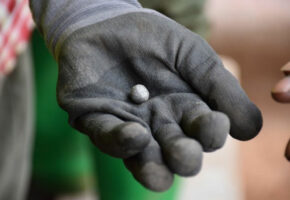
Cyrus Njonde Maina
Other posts by Cyrus
- Into the Field: Learning, Leading, and Growing with The Impact Facility
- Unlocking Kenya’s Mining Potential: Reflections from the 2024 Annual Mining Investment Conference and Expo
- The Impact Facility’s Experience On The Roll-Out of the Mine Investment Partnership Plans (IPPs)
- Formalisation and Financial Inclusion Dialogue of Artisanal and Small-scale Gold Mining in Kenya
- Empowering Women in Gold Processing Through Financial Literacy Training

 Due to the danger that mercury vapour poses to human bodies, it is vital that miners handle the element carefully. Artisanal and small-scale gold miners should distil mercury in a closed retort when working with amalgam. Not only will it ensure the
Due to the danger that mercury vapour poses to human bodies, it is vital that miners handle the element carefully. Artisanal and small-scale gold miners should distil mercury in a closed retort when working with amalgam. Not only will it ensure the  1. Bend the stainless-steel pipe to make a smooth curve at one end of the tube before cutting it.
1. Bend the stainless-steel pipe to make a smooth curve at one end of the tube before cutting it. 4. Make circular holes (½ inch in diameter) at the centre of each end of the sealed steel tube. A professional welder can make a hole with a normal welding flame or gas welding.
4. Make circular holes (½ inch in diameter) at the centre of each end of the sealed steel tube. A professional welder can make a hole with a normal welding flame or gas welding. 7. You can now weld the joint between the steel tube (the one meant to cool the mercury vapour) and the entry point of the stainless-steel pipe, making sure to leave a portion of it hanging 150 mm long on the reducer end.
7. You can now weld the joint between the steel tube (the one meant to cool the mercury vapour) and the entry point of the stainless-steel pipe, making sure to leave a portion of it hanging 150 mm long on the reducer end. The burning area shown as 4 and 9 is the area where the Gold amalgam is inserted for burning. Part 1, 2 and 3 are plumbing parts which close each other using threads. They are also made up of stainless steel so that the burning amalgam does not react with the metal parts.
The burning area shown as 4 and 9 is the area where the Gold amalgam is inserted for burning. Part 1, 2 and 3 are plumbing parts which close each other using threads. They are also made up of stainless steel so that the burning amalgam does not react with the metal parts.



